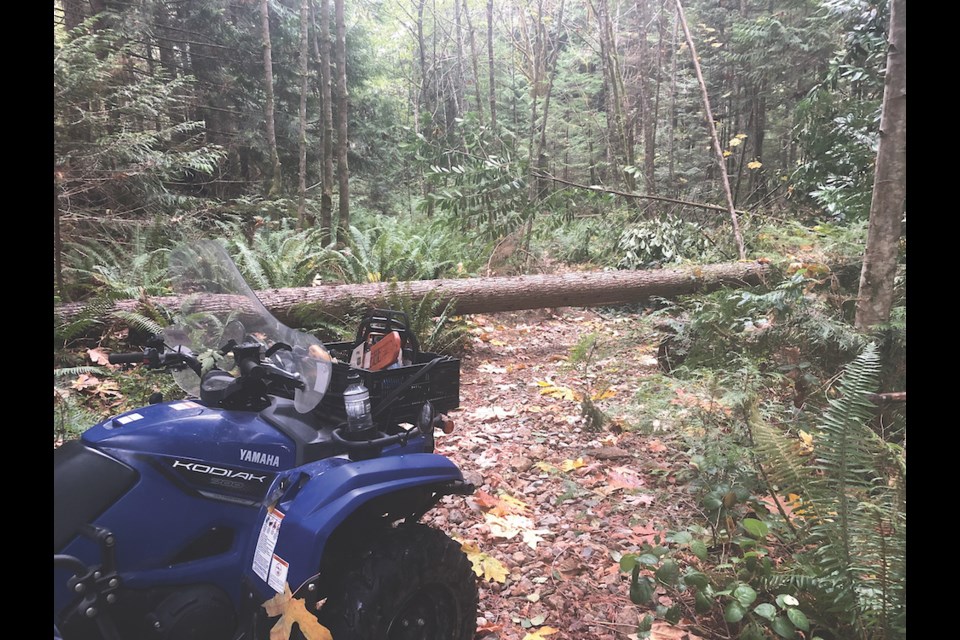The Sunshine Coast Regional District (SCRD) board has approved more than $200,000 in spending related to emergency repairs following a storm that affected the Coast on Nov. 4 and 5.
Those funds will come from a variety of on-hand reserves and will cover the costs of work done to date and ongoing efforts to complete storm repairs, the board heard at its Nov. 24 meeting.
The money will be paid back should costs be covered by claims on insurance or from Emergency Management BC. Staff advised that the timeframe on reimbursements was unknown but that they hoped to provide an update to elected officials on the situation before the end of 2022.
During that storm, the Hopkins Landing Waterworks District’s (HLWD) pumphouse was destroyed. According to a report provided at the Nov. 24 committee of the whole meeting, the SCRD stepped in to supply water from its nearby systems to the 170 properties normally served by the HLWD. SCRD staff’s estimate was that temporary supply would need to remain in place for another one to four weeks, until the HLWD can repair its infrastructure.
Along with approvals for onsite works, the board authorized staff to develop a mutual aid agreement with the HLWD for the provision of drinking water and to seek special authorization from the province under the Water Sustainability Act to permit the supply of water outside of the boundaries of the SCRD water system.
During discussion at the committee meeting, general manager of planning and development Ian Hall noted that interest has been expressed by the HLWD of having the SCRD take over responsibility for its system. He explained such a take over would be a lengthy process and require board approval, therefore having the agreement and authorization in place was an interim step to ensure safe supply of water to affected properties can be maintained.
Structural damage that did not impact operational equipment at the SCRD’s Reed Road water pumphouse and the Langdale wastewater treatment plant buildings also occurred during the storm. Adding to those damages were costs related to addressing downed trees at a variety of locations maintained by the regional district and overtime costs for staff working at an SCRD Emergency Operations Centre (EOC) established to coordinate storm response.
That EOC was separate and involved different staff members from the one already established for the Chapman water system drought situation.
BC Hydro response
The storm, which escalated into the night of Nov. 4, led to power outages peaking at about midnight, affecting 9,000 Sunshine Coast customers, Ted Olynyk, BC Hydro community relations manager for the Sunshine Coast told Coast Reporter.
Some residents went without power for at least four days.
Olynyk described the event as atypical for the Coast because outages weren’t concentrated in a single area. “This impacted the whole Sunshine Coast,” he said. Crews dealt with several broken power poles. The severity and widespread nature of the damage also stretched crews, he said.
The utility company has committed more resources to vegetation management across the province in response to increasingly severe storms and changing forest dynamics.
“When we have storms it’s no longer the one-off storm event that causes damage, it’s always what’s gone on before,” he said. “It’s all the previous stressors that have been put on trees in the South Coast now. Our vegetation didn’t develop for these conditions that they’re facing,” he said, citing extended droughts, intense storms and heat domes.
In the case of drought, trees essentially “walk out of the ground” once storms hit, because root structures lose their strength when a deluge of rain meets bone-dry earth and wind pounds trunks and branches.
Fluctuating seasonal patterns have also made an impact. In the Nov. 4 storm, for example, Olynyk said leaves were still clinging to trees, which “acted as sails,” causing trees to topple. Other trees were damaged so severely from the heat dome they were “barely hanging on,” making them far more vulnerable to wind, he said.
BC Hydro has a four-year vegetation cycle where staff manage trees that appear as risks. The public is also welcome to alert BC Hydro to trees that look risky, said Olynyk. “We’re responding more to public information about trees that are going to cause us grief.”
Trail damage
BC Parks did not report any damage to its Sunshine Coast locations, however, many Sunshine Coast trails were damaged, according to Sunshine Coast Trail Society president Julie Davidson.
“Trail elves” worked Langdale, Roberts Creek, West Sechelt, Halfmoon Bay and Pender Harbour, packing in chainsaws and hiking, mountain biking into the areas, or else accessing trails via ATVs, dirt bikes and even on horseback.
At least one volunteer dedicated seven hours to clear six trees on four trails, for example.
“There were no narrow singletrack trails unaffected,” said Davidson.
SCRD Area E director and trail association member Donna McMahon said the Coast Mountain Bike Trail Association “did an outstanding job” clearing trails in Sprockids Park in Langdale, which the organization maintains through a Memorandum of Understanding with the SCRD.
Warren Hansen, operations manager with Sunshine Coast Community Forest, said their forests experienced minor windthrow, but the organization considers such events in its forestry planning and apply mitigation measures along cutblock edges, including pruning and topping and “edge feathering.”
The public is invited to report trail damage via the Trailforks app or to [email protected].
With files from Sophie Woodrooffe



